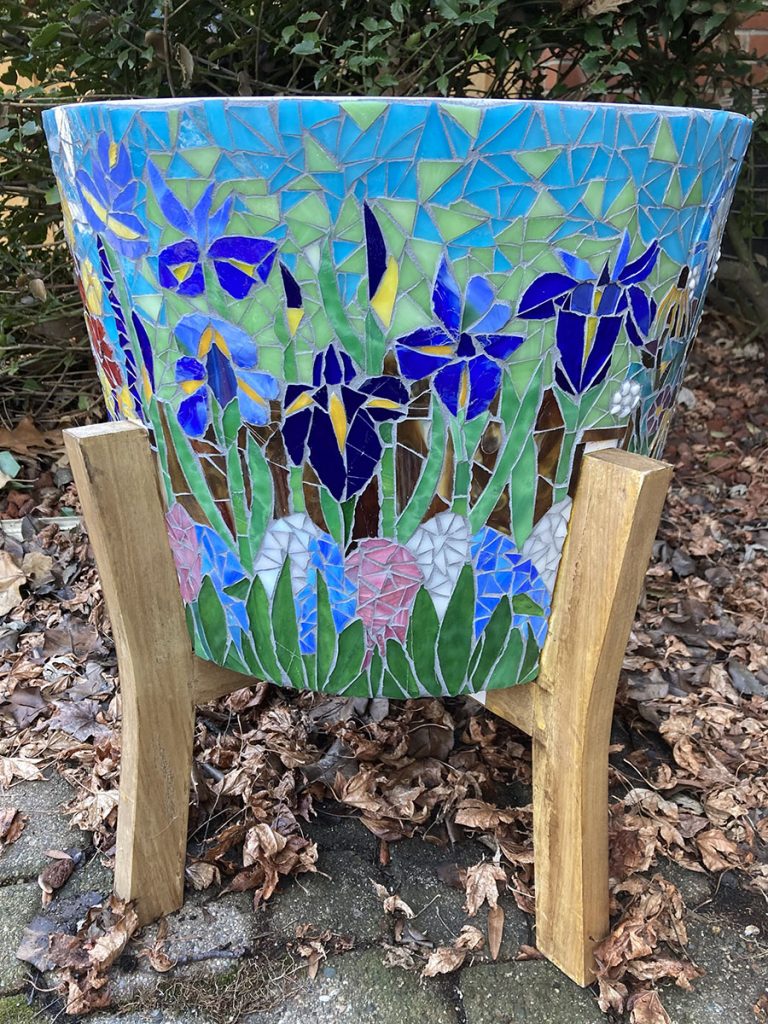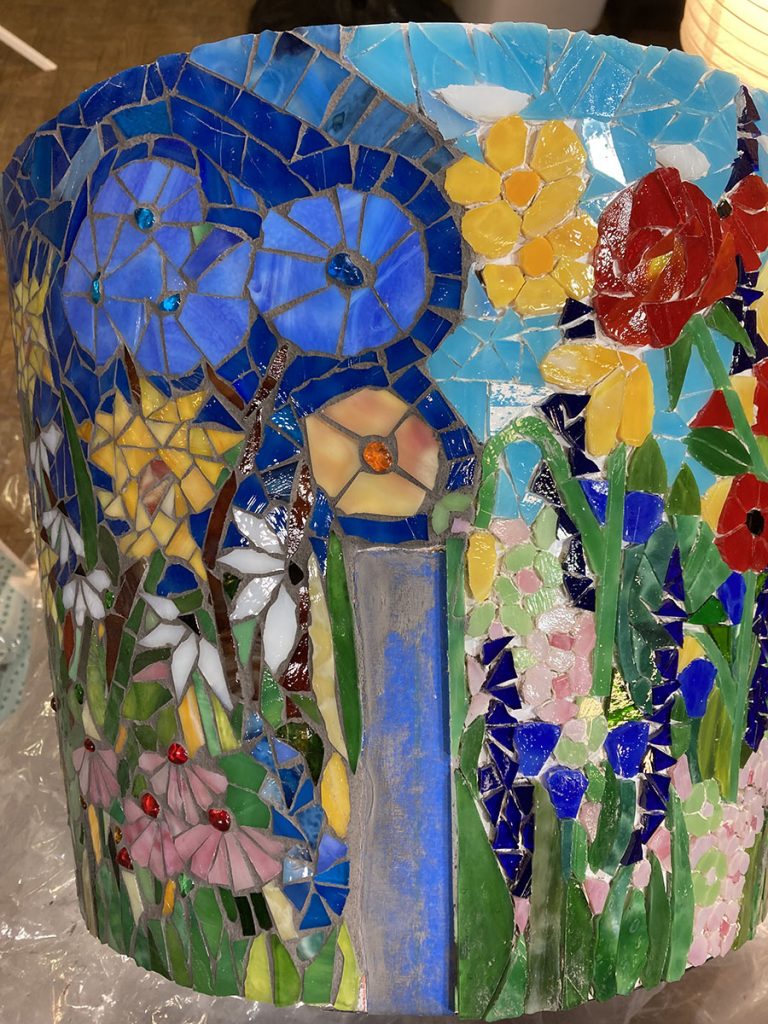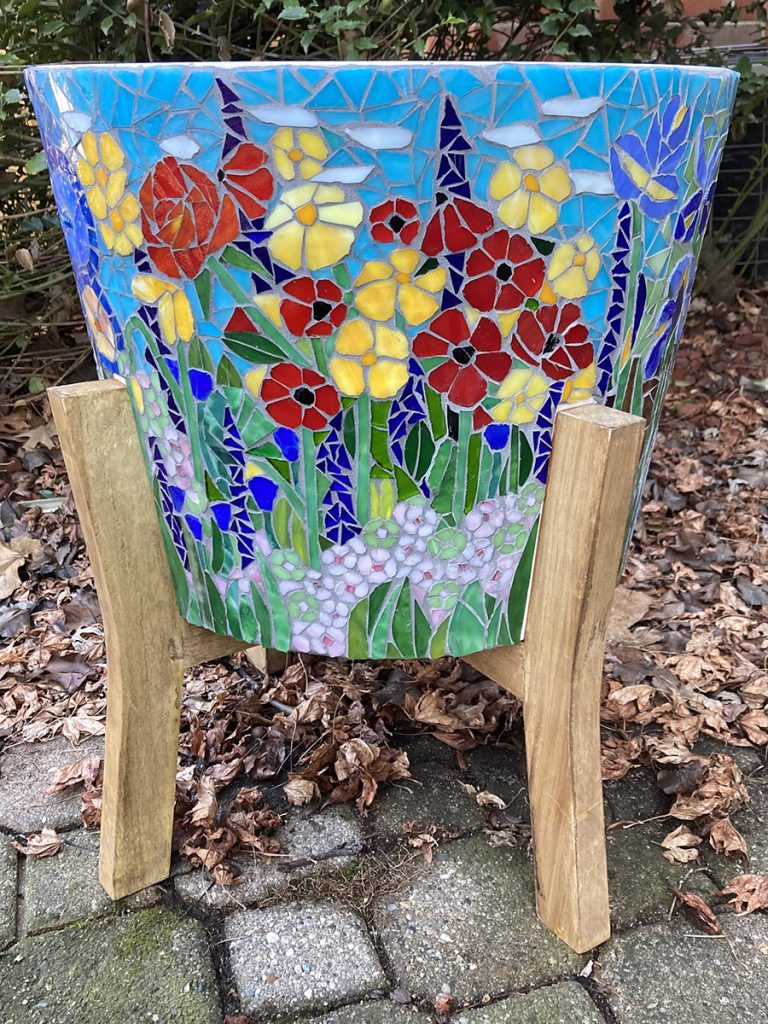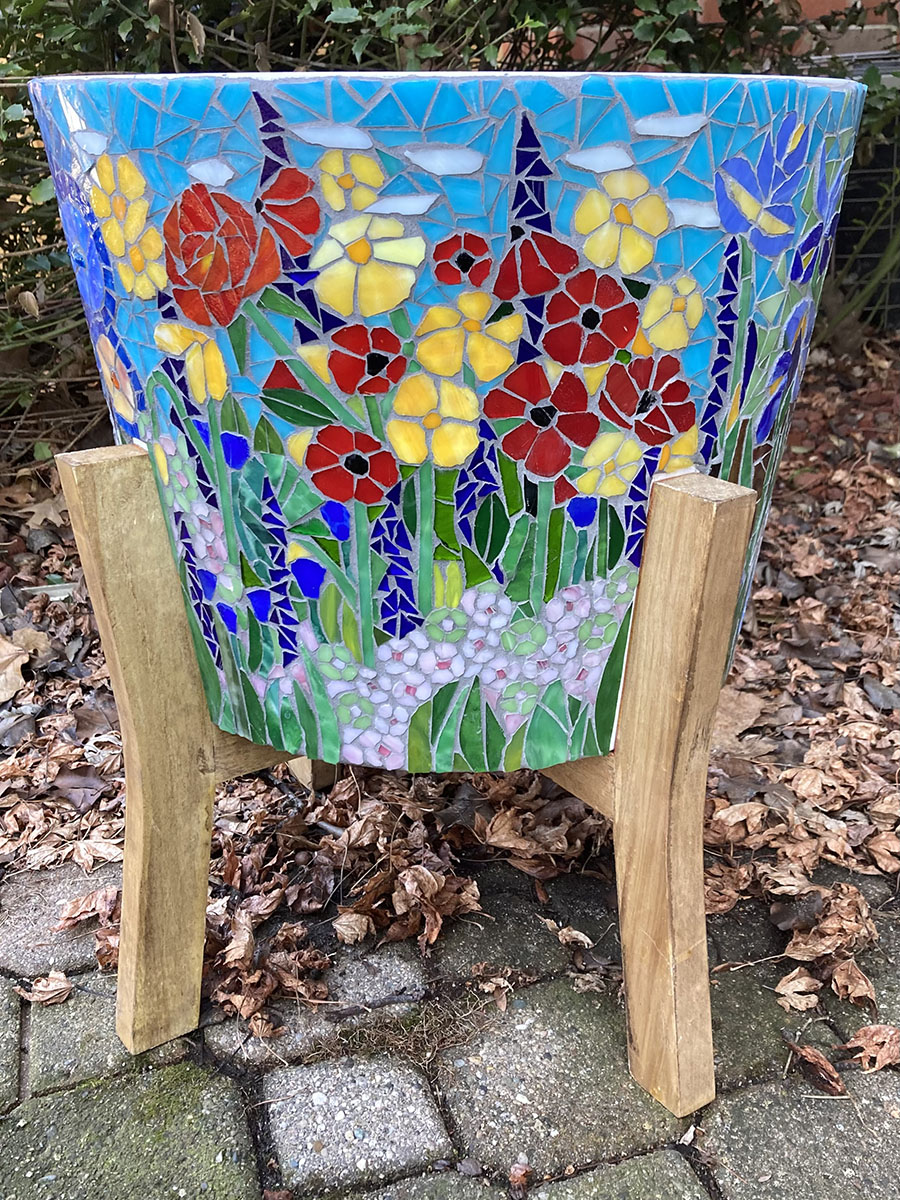Artist Donna Stern recently completed a round mosaic planter, which she grouted in sections.
I wanted to share that work for several reasons, and not merely because it is solid work with an emphasis on primary colors with a good balance of warm and cool colors.
There are several discussion points:
Donna left gaps in the mosaic to accommodate the three-posted stand that was used to hold the planter.
The planter itself is molded concrete or some other durable material instead of being a soft terracotta flower pot.
Donna mentioned using tiling schemes for some flowers based on observations of other artists’ mosaic flowers.
The main discussion point is how the mosaic planter was grouted in stages, but first some words about why grouting is so problematic, at least psychologically.

Grouting as Drama
Grouting mosaic artwork isn’t inherently difficult, but for a novice it can be psychologically difficult and stressful.
The reason is simple: The artist has spent many hours or weeks of precise cutting and fitting to create a colorful image, and then suddenly they have to dump something that looks like wet concrete on top of it.
The whole idea seems wrong and prone to problems.
Even for an experienced artist, there is always a little nagging doubt in the back of the mind. Am I ruining my mosaic? Will it look the same after grouting or will grouting expose problems? Will I have problems with haze or pitting because I didn’t work fast enough?
That is why I recommend using small grout gaps, which minimize the color impact of grouting and make the grouting process MUCH easier and faster.

In the image above, notice the un-grouted left half and the grouted right half. Also note the un-mosaiced strip where one of the stand posts will go.
Grouting in Sections
There are a few reasons why you might want to grout a mosaic in sections.
If the work is very large, or if the work is sculptural with inaccessible sides, or if you want to use different-colored grout in different areas, then you might want to consider grouting by sections.
BUT, there are strong incentives to do the grouting all at once.
Most of the work of grouting is cleaning up the buckets, tools, work area, and the mosaic itself. When you grout one section at a time, you have to do all that cleaning multiple times, and working with wet grout is inherently messy.
You also need to wait for 2 to 3 days between sections to allow the previous section to harden sufficiently.
You have to take steps to make sure that new grout can bond correctly to the old grout.
First you have to brush the edge of the old grout with an old toothbrush to make sure all crumbs have been removed, including any that might still be loosely attached.
Then you should moisten the existing grout to saturate it with water and let it dry on the surface.
The purpose of moistening is so the old grout doesn’t suck the moisture out of new grout. Otherwise a tiny crack will form between the grout sections, and the edge of that new grout along the crack will be soft and subject to flaking.

Practical Concerns
Stained glass is soft and fragile, and a planter full of wet soil is heavy. Donna wisely left gaps in the mosaic where the posts of the stand go.
Another option would be to mosaic that area and cut some makeshift pads from some old rubber gloves and place these between the post and the mosaic planter.
I didn’t think about doing that when Donna emailed me for advice, but I think that might be a better option because a gap “marries” the pot to the stand, and the pot can’t be displayed without the stand to hide the gaps.
However, for larger mosaic sculptures, rubber pads might not be sufficient.
It’s always best to think ahead. Avoid treating things like how the artwork will be displayed or mounted as afterthoughts.
Donna also showed good judgment by selecting a planter that was made from something other than soft terracotta.
Would you really want to spend the time making something this elaborate on a fragile terracotta flower pot?
Instead, find a planter made from molded concrete and avoid the heartbreak of seeing it get broken so soon.

Making Copies?
Donna told me that she “borrowed a fair amount of flower design ideas from others,” but I was relieved that she didn’t say “copied.”
Looking at other artwork as a model is fine and is something all the masters do.
My problem with the word “copy” isn’t ethical. My problem is that the word isn’t accurate for the process, at least not for imaginative artists. We can’t help but make our own version.
Improving Your Mosaic Artwork
Think about how much better this mosaic is precisely because Donna spent time looking at the different ways of rendering flowers. I think that might time have been as productive as the time spent looking at the flowers themselves.
Seeing flowers with a sharp artist’s eye isn’t the same as interpreting them in tile.
If looking at other artist’s work is necessary for developing as a painter or illustrator, it is certainly so for a mosaicist.
You can’t see how someone mixed or layered their paint, but you can see everything with mosaic.
Look for fine details suggested by a minimal number of tiles if you really want the inside secret.
Look for andamentos that work for particular shapes and curves and situations.
I look for andamentos that emphasize the shapes they are helping to render.
Other people notice how efficiently triangles nest to form complex shapes, such as the filigree sky background in this mosaic.
You can learn all this by looking.
Rule for “Copying”
When “copying” any aspect of another person’s artwork, always be asking yourself how you could make it better.
Some of us can’t help but do that.
We consider nineteen different ways we could have done whatever before committing. We see the world as a multiverse of possibilities.
Speaking of that, I have a suggestion…
Future Work
I think Cubism is an amazing way of expressing this concept via capturing multiple possible perspectives in the same figure.
I would love to see some cubist figurative mosaics, and I don’t mean interpretations of Picasso paintings, although those would be nice too.
I think the angular nature of cut tesserae might offer some possibilities to explore, specifically how the “multiple perspective panels” of Cubism might digress fractally to the level of individual tiles, at least in some places in the composition.



Leave a Reply